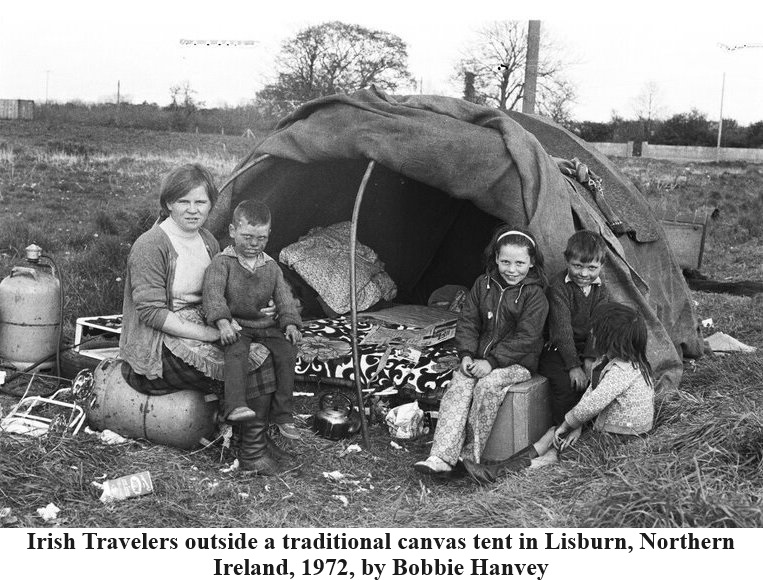There is an art to making a shelter out of next to nothing, and Human beings have been consummate shelter building artists for millennia. An ancient, and worldwide, shelter technique, that has stood the test of time from the paleolithic to today, and which inspired today’s pop-up tents, is the “Bender”.
Benders
are European and are very similar to Native American Wigwams. Traditionally they were associated with the
English Romany and English and Irish Travelers of the 19th and 20th
centuries, who practiced making shelters from bent poles of alder, willow or
hazel and then covering them with whatever they had at hand, such as “pieces
of old cloth, sacking, &c., to keep the rain and snow out”1.
To be able to make a survival shelter from whatever is at hand is a valuable skill that we should all practice, so let’s look at how it was done, back in the day. Benders are very similar to the “willow shelters” described in The Survival Training Guide, and are called benders, from the bent wooden poles that are tied together at the tops, to support the coverings.
There
are two types of benders, a round shaped one and a cylindrical one, which is
simply a circle lengthened by adding a section between the two halves. The fronts of both were frequently left open
to accommodate a campfire for heating and cooking.
So
how do you make a simple circular bender big enough to lay down in, what do you
do first?
First some
math...
So, if you start with a diameter of six feet (1.8 m), enough to lie down in, that means you will need a tarp or a square of canvas that isten feet by ten feet (3 m x 3 m) to cover your shelter.
And
to make a bender with a height that is one half its diameter, you will need
poles that are each about half the length of your canvas. However, if you want more headroom, then your
poles will need to be longer, about two thirds the length of your canvas. So, to make a round bender six feet (1.8 m)
in diameter, with 3 feet (.9 m) of head room, you will need seven, five foot
long poles.
Step
One, with a hatchet or camp knife, gather your poles and trim off the branches,
and then take them back to your camp site.
Step
Two, cut off strips of bark from the bottoms of your poles, about 18 inches (.5
m) long and about ½ wide (1.25 cm), with your knife, by placing the butt of the
pole against your chest and CAREFULLY cutting towards yourself. These strips of bark will be used to tie the
bent poles together, in Step Three.
Punch holes in the ground with a sharpened stick and push the poles into
the holes. Place the poles in a star
pattern, each about two feet to 2 feet, four inches apart (.6 - .68 m)2.
Step
Three, bend opposing poles together and tie them together into an arch, with one
of the strips of bark. Start with poles
two and six, then bend poles three and seven together, underneath poles two and
six and tie them together. Next, bend
poles five and one into an arch and tie them together. Last, bend pole four under the other arched
poles.
Step
Four, tie all the arched poles together with a strip of bark.
Step
Five, pull your tarp up and over the bent poles and weigh down the edges of the
tarp with rocks or logs.
Step
Six, make a bough bed, gather your firewood, and start your fire and watch the kettle
boil!
Author’s
Note -- building the bender shown in the pictures above, including gathering the
poles, took less than an hour.
Don’t forget to come back next week and read “Twinkle, twinkle, little
bat! ©”, where, since it is Halloween, we will talk about bats!
I
hope that you continue to enjoy The Woodsman’s Journal Online and look for me
on YouTube at BandanaMan Productions for other related videos, HERE. Don’t forget to follow me on both The
Woodsman’s Journal Online, HERE,
and subscribe to BandanaMan Productions on YouTube. If you have questions, as always, feel free
to leave a comment on either site. I
announce new articles on Facebook at Eric Reynolds, on Instagram at
bandanamanaproductions, and on VK at Eric Reynolds, so watch for me.
That
is all for now, and as always, until next time, Happy Trails!
Notes
1 Gipsy
Life, page 97, by George Smith
2
To make cylindrical bender you will need more poles and you will have to
arrange them in a “rib-cage pattern” on the sides, each about two feet to 2 feet, four inches apart (.6-.68 m).
From
“Instructions for making a bender tent”, HERE.
Sources
Department Of The Air Force, Survival
Training Edition, AF Manual 64-3,
[Air
Training Command, U.S. Government Printing Office, Washington, D.C., August 15,
1969], page 8-10, https://books.google.com/books?id=UaapWEpqo4cC&pg=PP3&lpg=PP3&dq=%22survival+training+edition%22+Af-64-3&source=bl&ots=EQPVWHeJ8j&sig=ACfU3U2tRMF4EHMi96DVdMj-9tV_MA3xWQ&hl=en&sa=X&ved=2ahUKEwimvOjN6vvnAhXEla0KHZPTAO44ChDoATABegQICRAB#v=onepage&q=%22survival%20training%20edition%22%20Af-64-3&f=false, accessed April 16, 2018
Dukeheart,
Coburn; “Like Father, Like Son: Creating Art In A Time Of Troubles”, by Bobbie Hanvey,
June 14, 2013, https://www.npr.org/sections/pictureshow/2013/06/14/191059207/like-father-like-son-creating-art-in-a-time-of-troubles,
accessed October 28, 2023
Hall, George, Rev.; The
Gypsy’s Parson, [Sampson, Low & Marston, Ltd., London, 1915], https://books.google.com/books?id=7Rs1AQAAIAAJ&printsec=frontcover&dq=%22The+Gypsy%27s+Parson%22&hl=en&newbks=1&newbks_redir=0&sa=X&ved=2ahUKEwivz5OI2peCAxVlJH0KHXnbC88Q6AF6BAgMEAI#v=onepage&q=%22The%20Gypsy's%20Parson%22&f=false,
accessed October 28, 2023
“Instructions for making
a bender tent”, from Gypsy Witchcraft & Magic, by Raymond Buckland,
Llewellyn publications, shown at https://www.enslin.com/rae/gypsy/bender.htm,
accessed October 28, 2023
Saville,
Alan; Mesolithic Scotland and its neighbours: the early Holocene prehistory
of Scotland, its British and Irish context, and some Northern European
perspectives, [2004], https://archaeologydataservice.ac.uk/library/browse/issue.xhtml?recordId=1147152&recordType=MonographSeriesChapter,
accessed October 27, 2023
Smith, George; Gipsy
Life, [Haughton & Co., London, 1880], page 97, https://books.google.com/books?id=Fo4BAAAAQAAJ&printsec=frontcover&dq=%22gipsy+life%22+%22george+smith%22&hl=en&newbks=1&newbks_redir=0&sa=X&ved=2ahUKEwiryJKq4fGAAxXOMVkFHci6Dj8Q6AF6BAgMEAI#v=onepage&q=%22gipsy%20life%22%20%22george%20smith%22&f=false,
accessed October 28, 2023
Wikimedia; “A doctor
examining an English Traveller girl in a bender tent (Swain after W. Small,
1898”, https://en.wikipedia.org/wiki/Bender_tent,
accessed October 28, 2023














No comments:
Post a Comment